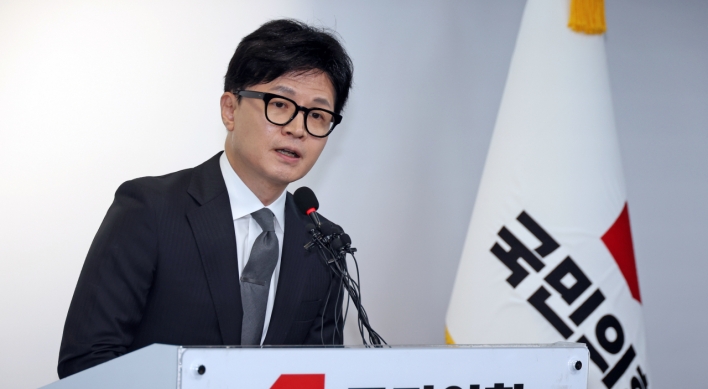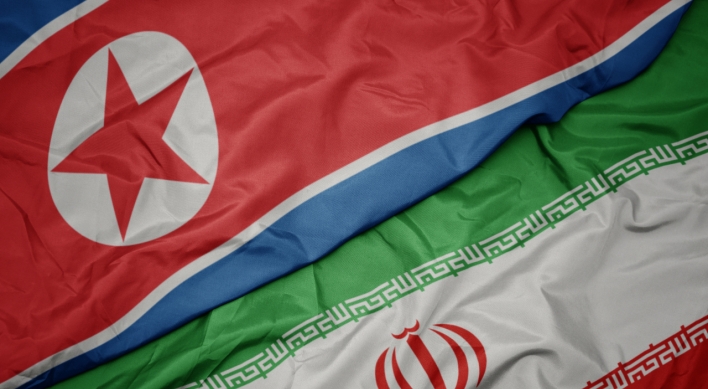[Editorial] R&D expenditure
Makeshift policies will not ensure reinvigoration
By 이현주Published : July 8, 2016 - 18:29
The government has unveiled measures, deregulations and tax rewards to reinvigorate newly emerging industries, amid growing concerns over a longer-than-expected export slump.
Its announcement, which was made at a trade promotion gathering chaired by President Park Geun-hye on Thursday, is drawing wide attention, as the government — in coordination with the private sector — has pledged to inject up to 4 trillion won ($3.4 billion) into prospective industries.
A project for a robot theme park in a southeastern region of the country will be fast-tracked, and legal barriers to build an industrial complex for the cosmetics sector in the central region will be lowered.
Policymakers also publicized a road map for the electric-vehicle sector. They are aiming to increase exports of EVs to 200,000 units a year by 2020, up from 12,000 units in 2015.
Korea’s traditional export items already face tough challenges in the saturated global market, so it is laudable that economy-related ministries are trying to foster futuristic industrial segments to find fresh growth engines.
For example, the rapidly emerging EV market may severely undermine Hyundai-Kia’s solid foothold if the Korean automotive group fails to keep up with high-end technologies via drastic investment in research and development.
The key lies in research and development, which could possibly determine the export-driven economy’s prosperity or decline in the coming decade.
State-led R&D spending increased by double-digit rates per annum in the late 1990s and early 2000s. But the incumbent administration has not followed suit in its yearly budget proposals.
The ratio of state R&D spending to gross domestic product reached 4.15 percent right after President Park took office in 2013. The R&D-to-GDP ratio is forecast to drop below 4 percent this year.
Some government officials say the reduction in R&D spending is meant to shift from quantitative to qualitative growth. Their explanation does not sound logical. What is needed is to strengthen efforts to increase the efficiency and effectiveness of R&D projects, rather than reducing expenditures.
It should be noted that developed countries like the U.S., Germany and Japan are continuing to expand R&D investment while pursuing better outcomes.
A lukewarm stance toward R&D spending is out of tune with the policies of the Park administration, which focus on promoting a creative economy by combining entrepreneurship and information and communications technology.
It is urgent for the government to draw up mid and long-term based polices, scrapping its temporary expedients.
Earlier this month, policymakers unveiled a stimulus package involving a 10 trillion won extra budget. But, simultaneously, doubts in the market over the efficacy of the coming policy are also mounting, as the ruling Saenuri Party suffered a surprise rout in the election.
While the government continues to strive to revitalize consumer sentiment, a structural barrier is hampering the move: Domestic demand has been trapped in a vicious circle in which quite a few citizens have little capacity to spend. The young have no regular income and the middle-aged are saddled with interest and principal-payment burdens.
The record-low interest rate, which stands at 1.25 percent per annum, has created risks in society overall during the past few years. Middle-income households have actively purchased apartments via risky mortgages on low rates, while college students and low-income households have taken loans on high rates from second- and third-tier financial firms, as they were rejected by first-tier banks.
Its announcement, which was made at a trade promotion gathering chaired by President Park Geun-hye on Thursday, is drawing wide attention, as the government — in coordination with the private sector — has pledged to inject up to 4 trillion won ($3.4 billion) into prospective industries.
A project for a robot theme park in a southeastern region of the country will be fast-tracked, and legal barriers to build an industrial complex for the cosmetics sector in the central region will be lowered.
Policymakers also publicized a road map for the electric-vehicle sector. They are aiming to increase exports of EVs to 200,000 units a year by 2020, up from 12,000 units in 2015.
Korea’s traditional export items already face tough challenges in the saturated global market, so it is laudable that economy-related ministries are trying to foster futuristic industrial segments to find fresh growth engines.
For example, the rapidly emerging EV market may severely undermine Hyundai-Kia’s solid foothold if the Korean automotive group fails to keep up with high-end technologies via drastic investment in research and development.
The key lies in research and development, which could possibly determine the export-driven economy’s prosperity or decline in the coming decade.
State-led R&D spending increased by double-digit rates per annum in the late 1990s and early 2000s. But the incumbent administration has not followed suit in its yearly budget proposals.
The ratio of state R&D spending to gross domestic product reached 4.15 percent right after President Park took office in 2013. The R&D-to-GDP ratio is forecast to drop below 4 percent this year.
Some government officials say the reduction in R&D spending is meant to shift from quantitative to qualitative growth. Their explanation does not sound logical. What is needed is to strengthen efforts to increase the efficiency and effectiveness of R&D projects, rather than reducing expenditures.
It should be noted that developed countries like the U.S., Germany and Japan are continuing to expand R&D investment while pursuing better outcomes.
A lukewarm stance toward R&D spending is out of tune with the policies of the Park administration, which focus on promoting a creative economy by combining entrepreneurship and information and communications technology.
It is urgent for the government to draw up mid and long-term based polices, scrapping its temporary expedients.
Earlier this month, policymakers unveiled a stimulus package involving a 10 trillion won extra budget. But, simultaneously, doubts in the market over the efficacy of the coming policy are also mounting, as the ruling Saenuri Party suffered a surprise rout in the election.
While the government continues to strive to revitalize consumer sentiment, a structural barrier is hampering the move: Domestic demand has been trapped in a vicious circle in which quite a few citizens have little capacity to spend. The young have no regular income and the middle-aged are saddled with interest and principal-payment burdens.
The record-low interest rate, which stands at 1.25 percent per annum, has created risks in society overall during the past few years. Middle-income households have actively purchased apartments via risky mortgages on low rates, while college students and low-income households have taken loans on high rates from second- and third-tier financial firms, as they were rejected by first-tier banks.


![[Exclusive] Korean military set to ban iPhones over 'security' concerns](http://res.heraldm.com/phpwas/restmb_idxmake.php?idx=644&simg=/content/image/2024/04/23/20240423050599_0.jpg&u=20240423183955)

![[Graphic News] 77% of young Koreans still financially dependent](http://res.heraldm.com/phpwas/restmb_idxmake.php?idx=644&simg=/content/image/2024/04/22/20240422050762_0.gif&u=)



![[Pressure points] Leggings in public: Fashion statement or social faux pas?](http://res.heraldm.com/phpwas/restmb_idxmake.php?idx=644&simg=/content/image/2024/04/23/20240423050669_0.jpg&u=)









